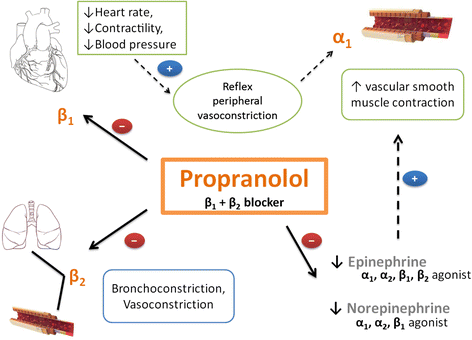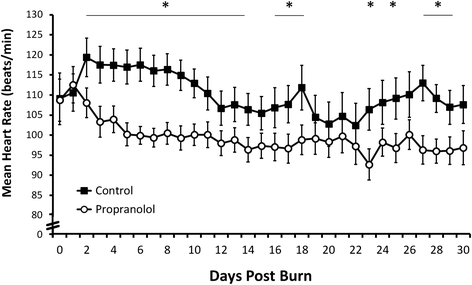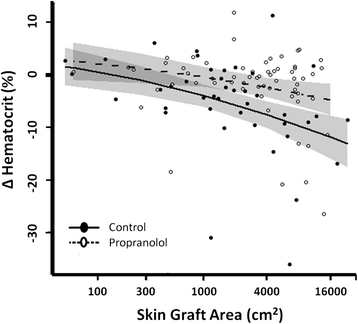Propranolol attenuates hemorrhage and accelerates wound healing in severely burned adults
- PMID: 25936635
- PMCID: PMC4432824
- DOI: 10.1186/s13054-015-0913-x
Propranolol attenuates hemorrhage and accelerates wound healing in severely burned adults
Abstract
Introduction: Propranolol, a nonselective β-blocker, exerts an indirect effect on the vasculature by leaving α-adrenergic receptors unopposed, resulting in peripheral vasoconstriction. We have previously shown that propranolol diminishes peripheral blood following burn injury by increasing vascular resistance. The purpose of this study was to investigate whether wound healing and perioperative hemodynamics are affected by propranolol administration in severely burned adults.
Methods: Sixty-nine adult patients with burns covering ≥ 30% of the total body surface area (TBSA) were enrolled in this IRB-approved study. Patients received standard burn care with (n = 35) or without (control, n = 34) propranolol. Propranolol was administered within 48 hours of burns and given throughout hospital discharge to decrease heart rate by approximately 20% from admission levels. Wound healing was determined by comparing the time between grafting procedures. Blood loss was determined by comparing pre- and postoperative hematocrit while factoring in operative graft area. Data were collected between first admission and first discharge.
Results: Demographics, burn size, and mortality were comparable in the control and propranolol groups. Patients in the propranolol group received an average propranolol dose of 3.3 ± 3.0 mg/kg/day. Daily average heart rate over the first 30 days was significantly lower in the propranolol group (P < 0.05). The average number of days between skin grafting procedures was also lower in propranolol patients (10 ± 5 days) than in control patients (17 ± 12 days; P = 0.02), indicative of a faster donor site healing time in the propranolol group. Packed red blood cell infusion was similar between groups (control 5.3 ± 5.4 units vs. propranolol 4.4 ± 3.1 units, P = 0.89). Propranolol was associated with a 5 to 7% improvement in perioperative hematocrit during grafting procedures of 4,000 to 16,000 cm(2) compared to control (P = 0.002).
Conclusions: Administration of propranolol during the acute hospitalization period diminishes blood loss during skin grafting procedures and markedly improves wound healing in severely burned adults. As burn patients require serial surgical interventions for motor and cosmetic repair, restricting blood loss during operative intervention is optimal.
Figures





Similar articles
-
Efficacy of propranolol in wound healing for hospitalized burn patients.J Burn Care Res. 2009 Nov-Dec;30(6):1013-7. doi: 10.1097/BCR.0b013e3181b48600. J Burn Care Res. 2009. PMID: 19826272 Clinical Trial.
-
Effects of human recombinant growth hormone on donor-site healing in burned adults.World J Surg. 2002 Jan;26(1):2-8. doi: 10.1007/s00268-001-0170-9. Epub 2001 Oct 25. World J Surg. 2002. PMID: 11898025 Clinical Trial.
-
Recombinant human growth hormone accelerates wound healing in children with large cutaneous burns.Ann Surg. 1994 Jul;220(1):19-24. doi: 10.1097/00000658-199407000-00004. Ann Surg. 1994. PMID: 8024354 Free PMC article. Clinical Trial.
-
[Experience of immediate burn wound excision and grafting for patients with extensive burns].Nihon Geka Gakkai Zasshi. 2005 Dec;106(12):745-9. Nihon Geka Gakkai Zasshi. 2005. PMID: 16869128 Review. Japanese.
-
The Effectiveness and Safety of Beta Antagonists in Patients With Burns: An Updated Meta-Analysis.Am Surg. 2025 May;91(5):772-783. doi: 10.1177/00031348251313991. Epub 2025 Jan 10. Am Surg. 2025. PMID: 39792849
Cited by
-
Short-term metformin and exercise training effects on strength, aerobic capacity, glycemic control, and mitochondrial function in children with burn injury.Am J Physiol Endocrinol Metab. 2018 Mar 1;314(3):E232-E240. doi: 10.1152/ajpendo.00194.2017. Epub 2017 Nov 14. Am J Physiol Endocrinol Metab. 2018. PMID: 29138224 Free PMC article. Clinical Trial.
-
Wound healing effect of an Astragalus membranaceus polysaccharide and its mechanism.Mol Med Rep. 2017 Jun;15(6):4077-4083. doi: 10.3892/mmr.2017.6488. Epub 2017 Apr 20. Mol Med Rep. 2017. PMID: 28440420 Free PMC article.
-
A 'metabolic bundle' including Oxandrolone in optimising the metabolic status of severely burn injured patients: a retrospective analysis of the first 50 patients.GMS Interdiscip Plast Reconstr Surg DGPW. 2019 Nov 15;8:Doc17. doi: 10.3205/iprs000143. eCollection 2019. GMS Interdiscip Plast Reconstr Surg DGPW. 2019. PMID: 31815086 Free PMC article.
-
β-Adrenergic blockade does not impair the skin blood flow sensitivity to local heating in burned and nonburned skin under neutral and hot environments in children.Microcirculation. 2017 May;24(4):10.1111/micc.12350. doi: 10.1111/micc.12350. Microcirculation. 2017. PMID: 28071840 Free PMC article. Clinical Trial.
-
Clonidine restores vascular endothelial growth factor expression and improves tissue repair following severe trauma.Am J Surg. 2017 Oct;214(4):610-615. doi: 10.1016/j.amjsurg.2017.06.019. Epub 2017 Jun 23. Am J Surg. 2017. PMID: 28666582 Free PMC article.
References
-
- Wilmore DW, Aulick LH. Metabolic changes in burned patients. Surg Clin North Am. 1978;58:1173–1187. - PubMed
Publication types
MeSH terms
Substances
Grants and funding
- R01-112936-01/PHS HHS/United States
- R01-GM056687/GM/NIGMS NIH HHS/United States
- R01 HD049471/HD/NICHD NIH HHS/United States
- P50-GM060338/GM/NIGMS NIH HHS/United States
- R01 GM112936/GM/NIGMS NIH HHS/United States
- UL1TR000071/TR/NCATS NIH HHS/United States
- UL1 TR000071/TR/NCATS NIH HHS/United States
- T32-GM008256/GM/NIGMS NIH HHS/United States
- R01 GM056687/GM/NIGMS NIH HHS/United States
- P50 GM060338/GM/NIGMS NIH HHS/United States
- T32 GM008256/GM/NIGMS NIH HHS/United States
- R01-HD049471/HD/NICHD NIH HHS/United States
LinkOut - more resources
Full Text Sources
Other Literature Sources
Medical
Research Materials

